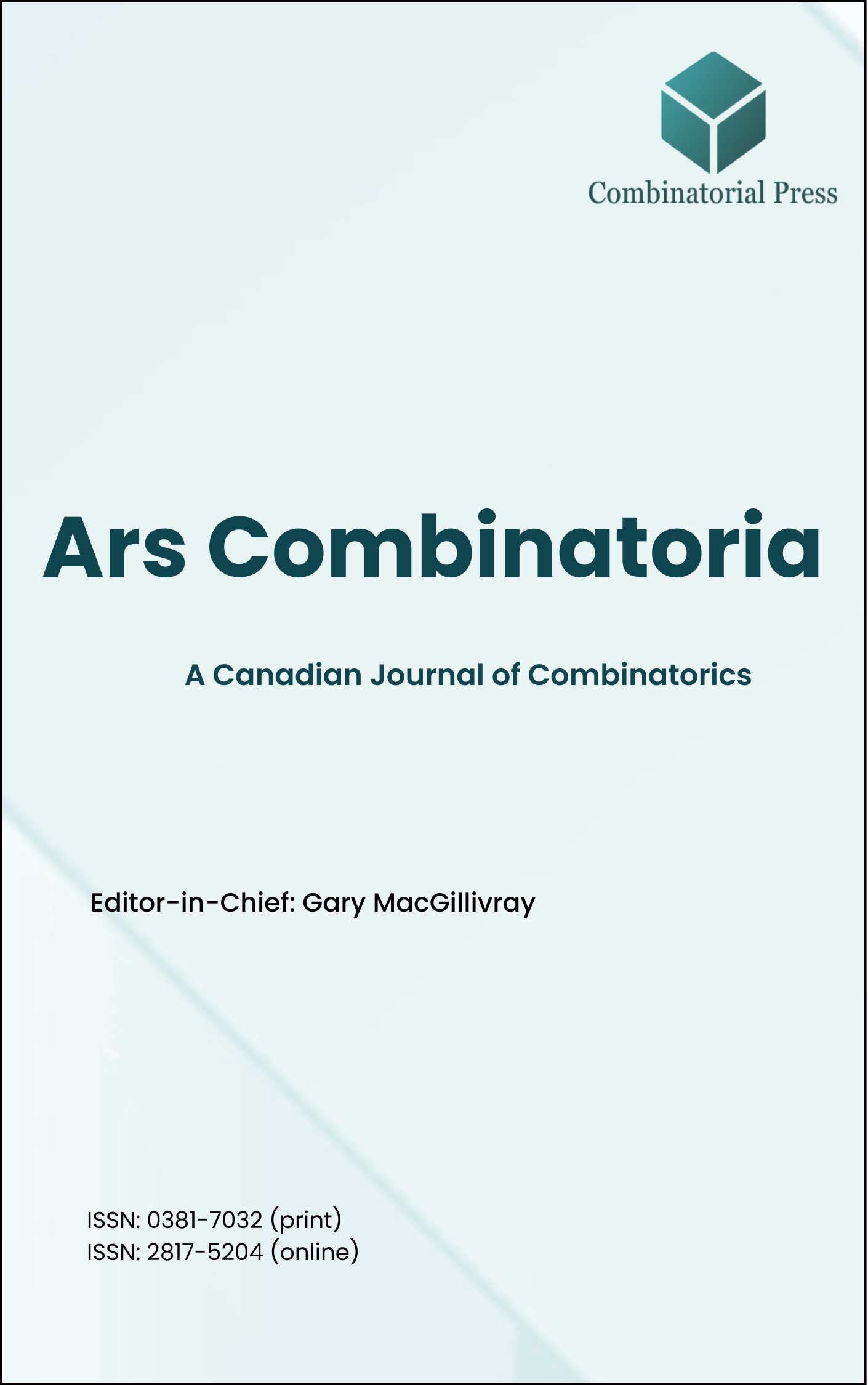
Ars Combinatoria
ISSN 0381-7032 (print), 2817-5204 (online)
Ars Combinatoria is the oldest Canadian Journal of Combinatorics, established in 1976. The journal is dedicated to advancing the field of combinatorial mathematics through the publication of high-quality research papers. From 2024 onward, it publishes four volumes per year in March, June, September and December. Ars Combinatoria has gained recognition and visibility in the academic community and is indexed in renowned databases such as MathSciNet, Zentralblatt, and Scopus. The Scope of the journal includes Graph theory, Design theory, Extremal combinatorics, Enumeration, Algebraic combinatorics, Combinatorial optimization, Ramsey theory, Automorphism groups, Coding theory, Finite geometries, Chemical graph theory but not limited.
Information Menu
- Research article
- Full Text
- Ars Combinatoria
- Volume 038
- Pages: 27-31
- Published: 31/12/1994
In \(1974\), G. Chartrand and R.E. Pippert first defined locally connected and locally \(n\)-connected graphs and obtained some interesting results. In this paper we first extend these concepts to digraphs. We obtain generalizations of some results of Chartrand and Pippert and establish relationships between local connectedness and global connectedness in digraphs.
- Research article
- Full Text
- Ars Combinatoria
- Volume 038
- Pages: 7-25
- Published: 31/12/1994
An infinite countable Steiner triple system is called universal if any countable Steiner triple system can be embedded into it. The main result of this paper is the proof of non-existence of a universal Steiner triple system.
The fact is proven by constructing a family \(\mathcal{S}\) of size \(2^{\omega}\) of infinite countable Steiner triple systems so that no finite Steiner triple system can be embedded into any of the systems from \(\mathcal{S}\) and no infinite countable Steiner triple system can be embedded into any two of the systems from \(\mathcal{S}\) (it follows that the systems from \(\mathcal{S}\) are pairwise non-isomorphic).
A Steiner triple system is called rigid if the only automorphism it admits is the trivial one — the identity. An additional result presented in this paper is a construction of a family of size \(2^{\omega}\) of pairwise non-isomorphic infinite countable rigid Steiner triple systems.
- Research article
- Full Text
- Ars Combinatoria
- Volume 038
- Pages: 3-5
- Published: 31/12/1994
A graph \(G\) having a \(1\)-factor is called \(n\)-extendable if every matching of size \(n\) extends to a 1-factor. We show that
if \(G\) is a connected graph of order \(2p (p \geq 3)\), and g and n are integers, \(1 \leq n < q < p\), such that every induced connected
subgraph of order \(2q\) is \(n\)-extendable, then \(G\) is n-extendable.
- Research article
- Full Text
- Ars Combinatoria
- Volume 037
- Pages: 309-318
- Published: 30/06/1994
Certain graphs whose vertices are some collection of subsets of a fixed \(n\)-set, with edges determined by set intersection in some way, have long been conjectured to be Hamiltonian. We are particularly concerned with graphs whose vertex set consists of all subsets of a fixed size \(k\), with edges determined by empty intersection, on the one hand, and with bigraphs whose vertices are all subsets of either size \(k\) or size \(n-k\), with adjacency determined by set inclusion, on the other. In this note, we verify the conjecture for some classes of these graphs. In particular, we show how to derive a Hamiltonian cycle in such a bigraph from a Hamiltonian path in a quotient of a related graph of the first kind (based on empty intersection). We also use a recent generalization of the Chvatal-Erdos theorem to show that certain of these bigraphs are indeed Hamiltonian.
- Research article
- Full Text
- Ars Combinatoria
- Volume 037
- Pages: 301-308
- Published: 30/06/1994
We determine the minimal number of queries sufficient to find an unknown integer \(x\) between \(1\) and \(n\) if at most one answer may be erroneous. The admissible form of query is: “Which one of the disjoint sets \(A_1, \ldots, A_k\) does \(x\) belong to?”
- Research article
- Full Text
- Ars Combinatoria
- Volume 037
- Pages: 288-300
- Published: 30/06/1994
A \(\lambda\)-packing of pairs by quintuples of a \(v\)-set \(V\) is a family of \(5\)-subsets of \(V\) (called blocks) such that every \(2\)-subset of \(V\) occurs in at most \(\lambda\) blocks. The packing number is defined to be the maximum number of blocks in such a \(\lambda\)-packing. These numbers are determined here for \(\lambda \equiv 0 \mod 4\) and all integers \(v \geq 5\) with the exceptions of \((v, \lambda) \in \{(22, 16), (22, 36), (27, 16)\}\).
- Research article
- Full Text
- Ars Combinatoria
- Volume 037
- Pages: 275-287
- Published: 30/06/1994
Recently, there has been substantial interest in the problem of the spectrum of possible support sizes of different families of BIB designs. In this paper, we first prove some theorems concerning the spectrum of any \(t\)-design with \(v = 2k\) and \(k = t + 1\), and then we study the spectrum of the case \(4-(10, 5, 6m)\) in more detail.
- Research article
- Full Text
- Ars Combinatoria
- Volume 037
- Pages: 262-274
- Published: 30/06/1994
We obtain bounds for the separation number of a graph in terms of simpler parameters. With the aid of these bounds, we determine the separation number for various special graphs, in particular multiples of small graphs. This leads to concepts like robustness and asymptotic separation number.
- Research article
- Full Text
- Ars Combinatoria
- Volume 037
- Pages: 257-261
- Published: 30/06/1994
A.M. Assaf, A. Hartman, and N. Shalaby determined in [1] the packing numbers \(\sigma(v, 6, 5)\) for all integers \(v \geq 6\), leaving six open cases of \(v = 41, 47, 53, 59, 62,\) and \(71\). In this paper, we deal with these open cases and thus complete the packing problem.
- Research article
- Full Text
- Ars Combinatoria
- Volume 037
- Pages: 241-256
- Published: 30/06/1994
A hypergraph \(H\) is called connected over a graph \(G\) with the same vertex set as \(H\) if every hyperedge of \(H\) induces a connected subgraph in \(G\). A graph \(F\) is representable in the graph \(G\) if there is some hypergraph \(H\) which is connected over \(G\) and has \(F\) as its intersection graph. Generalizing the well-known problem of representability in forests, the following problems are investigated: Which hypergraphs are connected over some \(n\)-cyclomatic graph, and which graphs are representable in some \(n\)-cyclomatic graph, for any fixed integer \(n\)? Several notions developed in the theory of subtree hypergraphs and chordal graphs (i.e. in the case \(n = 0\)) yield necessary or sufficient conditions, and in certain special cases even characterizations.





